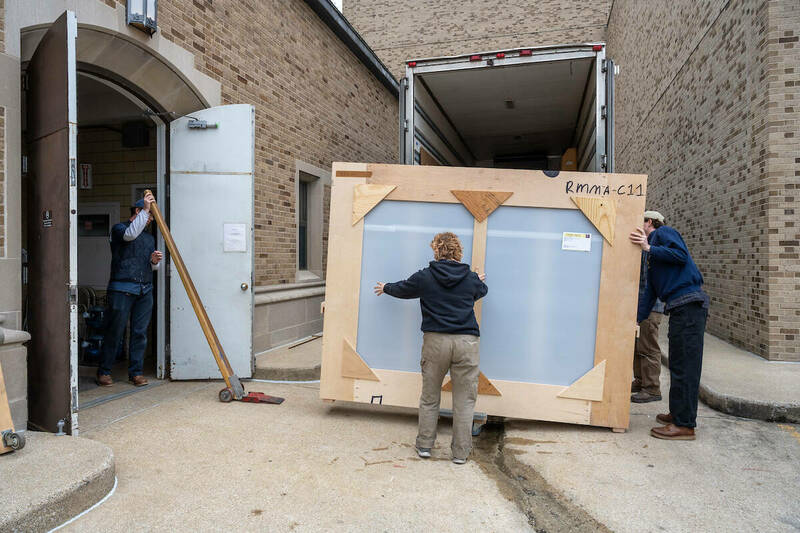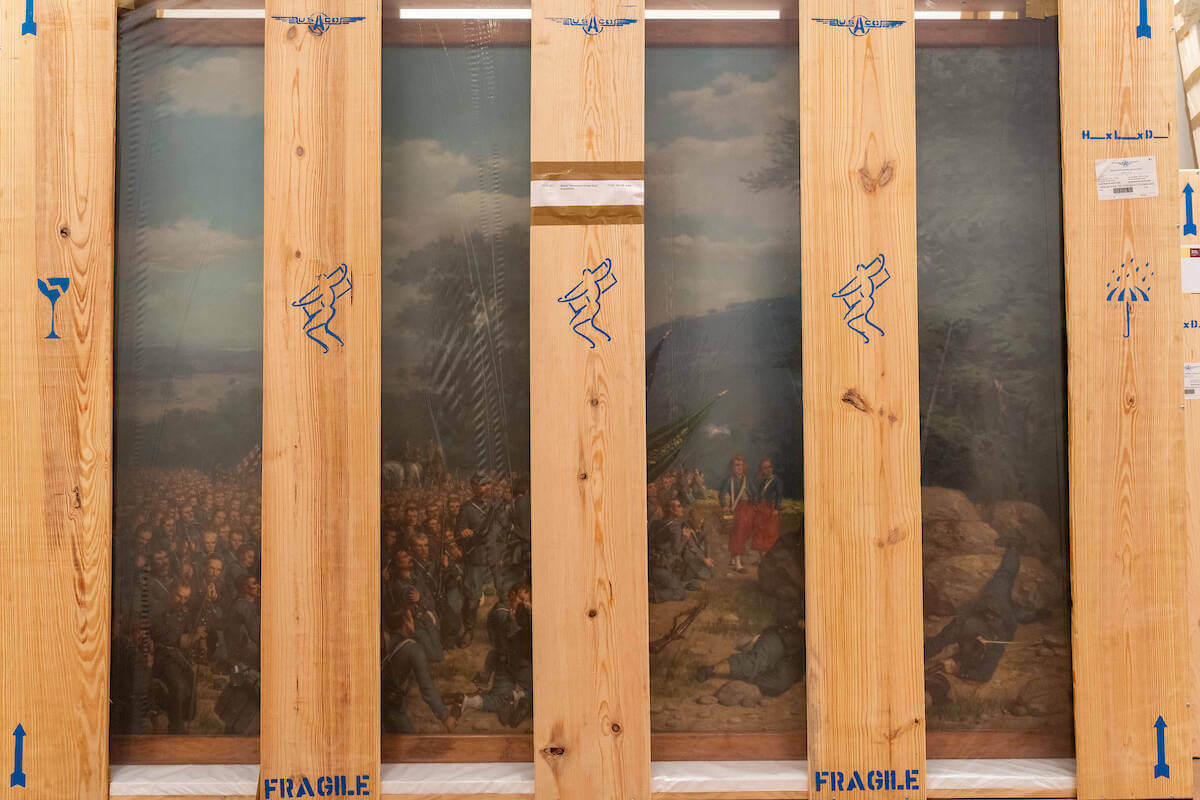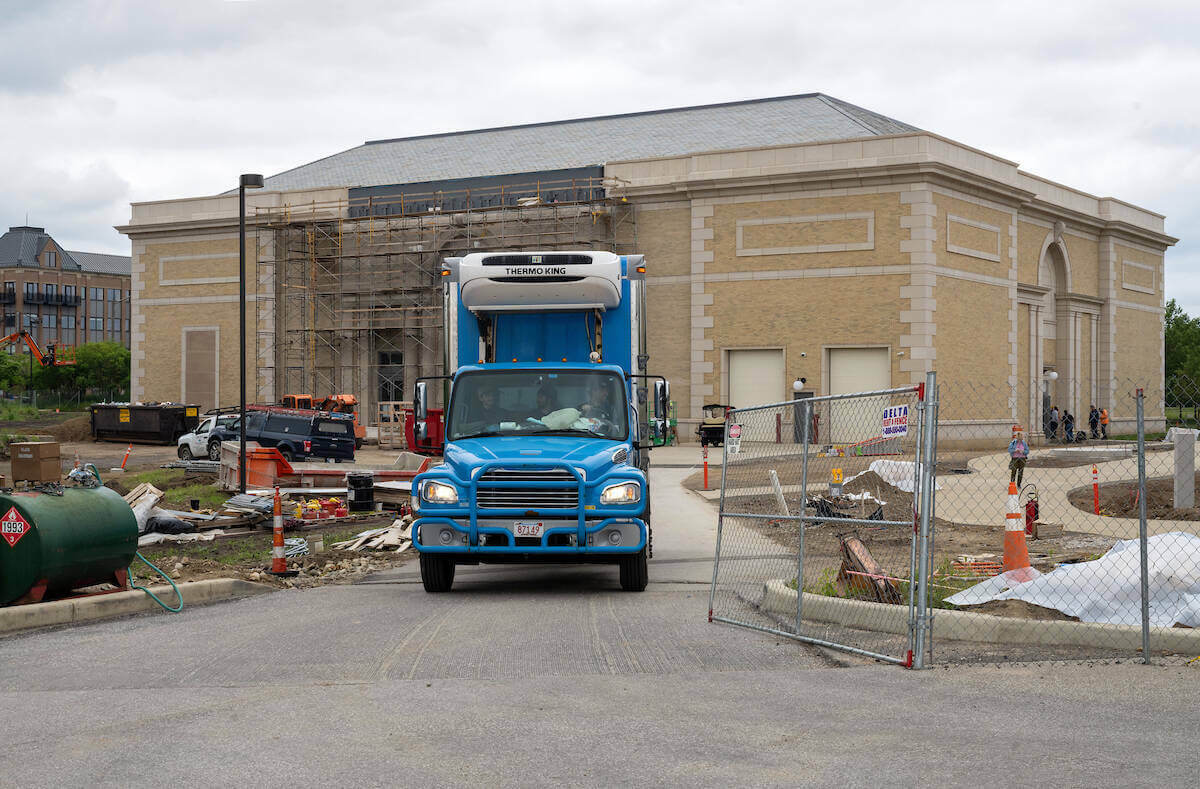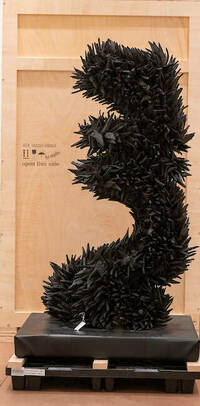 Movers lift a painting in a custom-made crate into a truck at Snite Museum loading dock. Photography by Barbara Johnston
Movers lift a painting in a custom-made crate into a truck at Snite Museum loading dock. Photography by Barbara Johnston
Editor’s Note: This is part of a Notre Dame Magazine series documenting the move from the Snite Museum to the new Raclin Murphy Museum.
- Snite Moves
- Packed Schedule
- Moving Works of Art
- Museum Pieces
- Divine Inspiration
- Raclin Murphy Readies for Its Debut
It’s early summer on the mostly vacant campus when a blue box truck pulls up at the south end of O’Shaughnessy Hall. A few pedestrians pass by without a glance, oblivious to the unmarked vehicle parked in the alley.
Soon a half dozen people started rolling crated and packaged objects out a door on dollies and loading them into the truck. It has all the makings of a heist film, but this production is more meticulously planned than a summer cinema blockbuster.
June 12 was the start of moving week for part of Notre Dame’s art collection. About 500 works of art (from a collection that totals nearly 30,000 objects) are being carefully transported from the former Snite Museum of Art (which closed its doors in April) to their new home.
Each cardboard box or crate is labeled with a sticker identifying the object, the artist, the medium and color coding to indicate its gallery destination. Each carton also is marked “RMMA” — for Raclin Murphy Museum of Art, the new facility at the south edge of campus that will open in November.

How do you move hundreds of valuable works of art four-tenths of a mile down the road? First you pack them as if they were being prepared for a cross-country journey.
Then you proceed by hand, ever so gently and one object at a time. A hand-pushed dolly is used to move the items out the door, a rear lift raises the dolly to the truck bed level, then professional art movers do the work of easing the pieces into place. Once in the truck bed, the art objects are cushioned with more cardboard, then held in place with strong nylon straps.
The artworks are so carefully protected they aren’t visible to the eye. But the stickers reveal their identities. That box contains Forging the Cross, a 1904 painting by American artist Henry Mosler. There’s a large crate that holds Memento Mori: Death Comes to the Table, a 17th-century painting by Italian artist Giovanni Martinelli. Soon after comes Bernese Alps, an 1859 work by American artist Albert Bierstadt.
Waiting their turn in the wings are bulkier crated objects, including African figures, French busts and 20th century kinetic sculptures. Some of the cartons are 6-by-6 feet or larger and heavy, requiring several pairs of hands to ease them into the truck.
After the truck bed is full, the vehicle’s back doors close and two heavy locks are snapped shut. The driver takes a route along the edge of campus, to avoid passing over speed bumps.
Ten minutes later, in the rear loading dock of the new museum, the entire exercise plays out in reverse. A built-in electric lift lowers the dolly to the floor, then the artworks are pushed a few yards to a freight elevator large enough to fit an SUV, to be transported to their temporary storage area in Raclin Murphy.

Museum registrar Victoria Perdomo carefully checks in each item on a computer tablet as it leaves the vehicle.
The process moves like clockwork. By early afternoon two days later, the box truck has completed six trips and a semi truck made one trip to transport larger works. No spills or pitfalls.

“There were a couple of large objects, but they were all packed so well I don’t think we were worried about anything,” says Laurene Grunwald, associate director of Raclin Murphy museum. She declares the move a success.
In a secure space in the new building, the boxed art treasures are neatly placed in temporary storage. The large dramatic 1891 painting Absolution Under Fire — a favorite among museum visitors, depicting Father William Corby, CSC, blessing the troops before the Battle of Gettysburg — is visible through its crating near the north wall. Nearby stands Latent Emissions, a 1998 sculpture crafted of salvaged rubber tires by artist Chakaia Booker.
Smaller scale moves of the collection’s items will continue over the next few months. By late June, the work of unpacking, placing and arranging some paintings will start in the new galleries.
Thus, the life of the new museum begins.
Margaret Fosmoe is an associate editor of this magazine. She can be reached at mfosmoe@nd.edu or @mfosmoe.